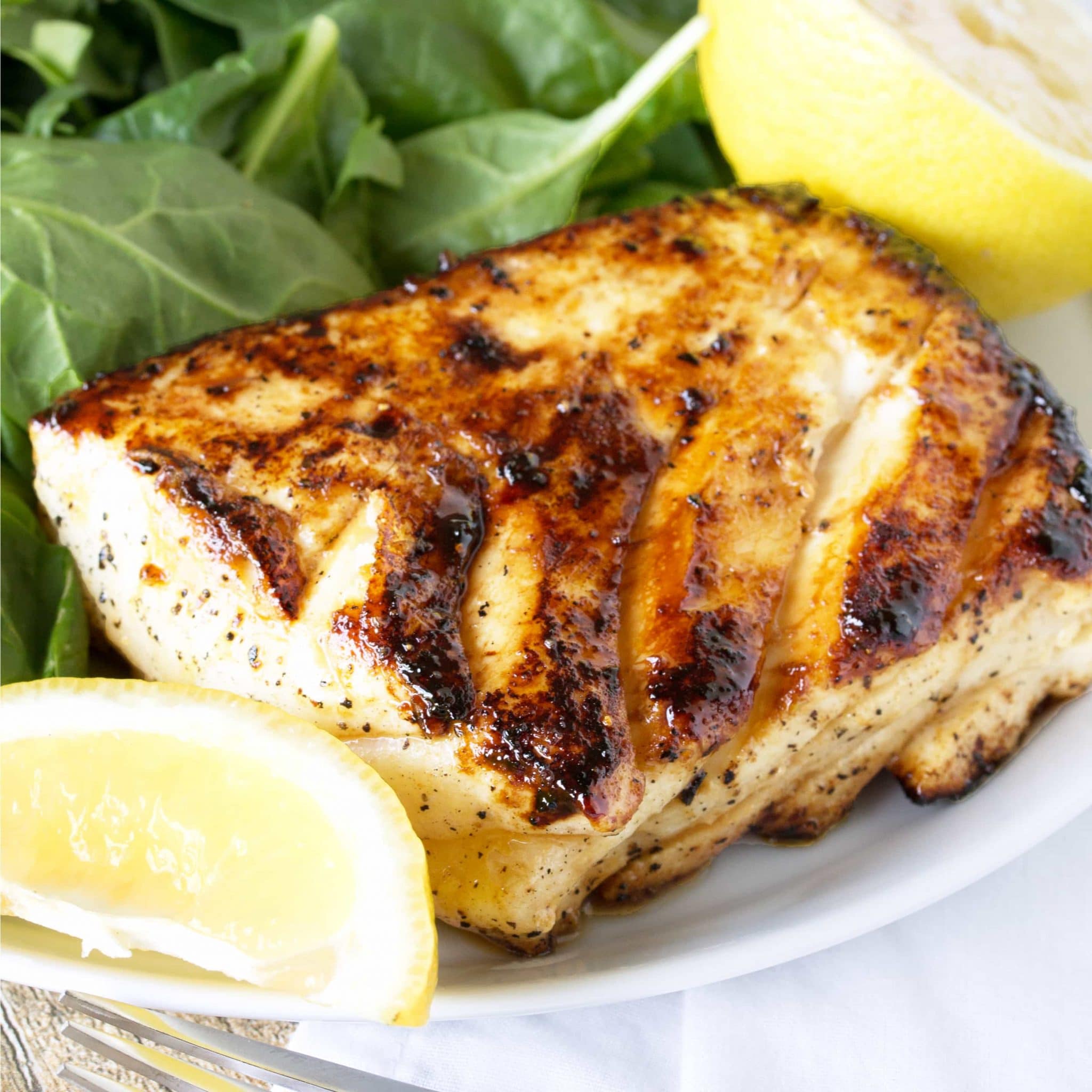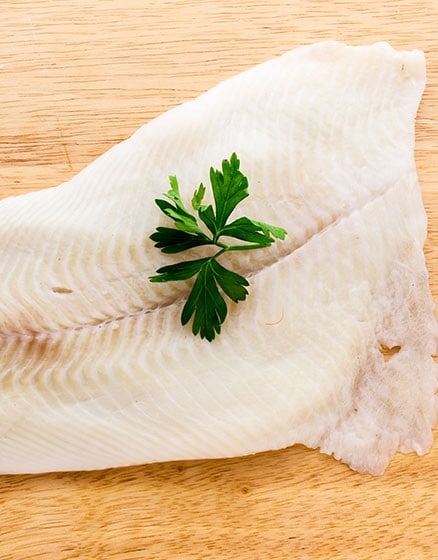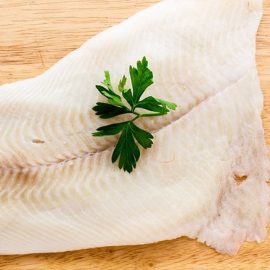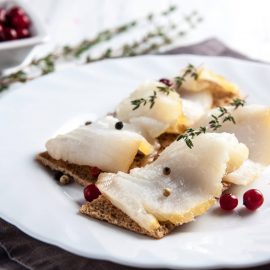
Introduction
Halibut (genus Hippoglossus) is the largest flatfish found in the North Atlantic and Pacific Ocean. Known for their mild-tasting flesh, they are a significant food source for many animals, including humans.
It is a type of saltwater flatfish that is widely sought-after by fisheries across the globe. Its succulent texture and mild flavour make it a highly sought-after food fish, enjoyed by both commercial and recreational fishermen.
As an apex predator, halibut play a vital role in the ocean ecosystem, helping to maintain a steady balance between different species.
Physical Characteristics
Halibut species are recognised for their remarkable physical characteristics, adapted to keep the species hidden to ambush predators and prey. These include their flattened body shape, large eyes, and extended triangular pectoral fins, which aid in silent movement along the ocean floor.
The fish’s underside is white, and the top is usually mottled with shades of green and dark brown. They are frequently found in abundance on North American and European coasts and parts of Asia.
Habitat
Halibut are found in most cold, murky waters, feeding mainly on smaller fish, squid and crustaceans. They inhabit depths of up to 900 m, blending in with the surrounding ocean floor.
Fishery & Ecology
Halibut has been an essential resource in the North Pacific for thousands of years, with records of fishing the species dating back to the seventeenth century. It is harvested commercially and recreationally today, although the species’ population is considered overfished, with declining numbers in recent years. Research has been conducted to better understand the species’ population structure, age, and growth, with organisations offering resources and advice on sustainable and responsible fishing methods.
However, their populations have been heavily reduced due to overfishing, resulting in many areas being managed as protected grounds by the National Marine Fisheries Service (NMFS). Halibut are considered prey to many marine predators, such as sharks, seals, and whales. They are known for their strength and resilience, making them a challenging catch for anglers.

Population and Conservation
Atlantic Halibut are especially sought-after in the commercial fishing industry, with some populations beginning to decline due to overfishing. Catch limits, gear regulations, and bycatch reductions have been implemented to ensure the sustainability of this species.
Distribution of Stocks
They have a wide distribution range, being found in the North Sea, Greenland, Scandinavia, the Arctic and Alaskan waters.
Conservation Status
The halibut population is continuing to decline due to overfishing and environmental pollution. This decrease in population poses an increased threat to the species.
Conservation efforts focus on removing fishing nets from many habitats where halibut can be found, increasing the size and number of marine reserves, and using unique management plans for areas where halibut inhabit.
Sustainability
Due to their slow reproductive cycle and vulnerability to overfishing, decreasing populations of halibut have been recorded in many areas. The International Pacific Halibut Commission (IPHC) has implemented a harvest strategy that includes maximum catch limits, controlled entry into the fishery, and quota allocations to combat this.
In certain areas, there have been bans or restrictions placed on trawling to reduce overfishing, while longline fisheries are used to provide better quality control over catch. By providing safe habitats for halibut, Marine Protected Areas (MPAs) can also be used to boost halibut populations. At the same time, recreational anglers can enhance sustainability by using sustainable fishing methods, properly releasing any caught fish, and avoiding destructive techniques such as dredging.
Finally, scientific collaboration between fisheries, educational programmes to promote sustainable fishing practices, and aquaculture use to decrease pressure on wild populations all contribute to the ongoing sustainability of the halibut.
Diet and Feeding Habits
When feeding, very large halibut filters plankton from upwelling currents with gill rakers and consumes small crustaceans, worms, crabs, and shrimp during the day. As they age and grow, their diets may include larger fish, such as herring or salmon, shrimp, lobster and other marine creatures.
Reproduction
Halibut are semelparous, meaning they only spawn once in their lifetime, typically during the spring and summer. Males usually mature earlier than females and initiate courtship by swimming around the females for several days to attract their attention.
Spawning occurs in open water, and the fertilised eggs drift in the ocean currents until the larvae hatch and settle on the sea floor. After 2-3 weeks, the larvae grow and eventually reach maturity – typically 10-20cm in length.
Halibut continue to grow throughout their lives, with females usually becoming larger than males.
Life Cycle of Halibut
Halibut have several different life cycles depending on the species; however, all require an extended period in deeper waters before returning to shore to spawn. During this period, they primarily feed on small fish, invertebrates, plankton, and other organic materials.
During the juvenile stage, halibut move offshore to deeper waters and face further changes in their body shape, after which they remain in this habitat for the rest of their life.
Environmental factors, such as temperature, food availability, and age, impact halibut’s size and maturity. On average, halibut reach sexual maturity when they reach distances of 9-10 inches long, which usually occurs 3-5 years after they are born, with some growing to be up to 200kg or more. Depending on the species, female halibut can produce up to 6 million eggs each.
Culinary Uses
Halibut is a culinary delicacy consumed by many cultures around the world. It is typically prepared by grilling, poaching, baking, broiling or frying and serves as an excellent source of healthy fats, vitamins and minerals.
Significance
Halibut is an integral part of marine ecosystems, as they feed on bottom-dwellers and help keep the ocean floor clean and free from algae. They are also enjoyed by humans as a sustainable source of protein and are commonly caught for commercial and recreational fishing. For this reason, it is crucial to maintain the diet and environment of halibut to ensure their population thrives and the oceanic ecosystem remains balanced.
Uses and Importance
Halibut is an important food fish, providing an essential source of protein across the Atlantic and Pacific regions. Halibut is both a high-quality white fish and a popular sport fish that is sustainably fished.
Halibut is available in various forms, including fresh, frozen, or smoked whole Halibut or large fillets and is a popular ingredient in sushi. It is an essential fish to the fishing industry and is an increasingly popular seafood choice among consumers.
Nutritional Values
Halibut is an excellent source of omega-3 fatty acids, specifically EPA and DHA, essential for brain health and function. It is also a good source of protein, vitamins A and D, and minerals such as potassium, phosphorus, calcium, magnesium and selenium.
Compared to other types of fish, halibut has a lower fat content and similar amounts of protein. It is also lower in mercury than different types of white fish.
Health Benefits
Eating a diet rich in lean proteins from sources such as halibut is associated with numerous health benefits, including reducing inflammation, increasing muscle mass, and preventing muscle catabolism.
Halibut provides a unique and delicious seafood option that is often a better alternative than other types of fish. Nutrient-rich and versatile, Halibut is an excellent source of lean protein and essential vitamins and minerals and is generally low in contaminants such as mercury and PCBs.
Versatility
Found in the cold, deep waters of the North Pacific, Atlantic, and Arctic oceans, halibut are a type of flat fish and one of the most popular fish species in the world. Known for its delicate texture and mild flavour, Halibut is a versatile fish that can be prepared with a variety of marinades, glazes, sauces, and cooking methods. From baking and poaching to grilling and searing, this fish can be cooked in many different ways to provide the perfect bite.
Cooking and Uses of Large Halibut
Halibut can be cooked in various ways due to its versatile flavour, which can be paired with many ingredients. Its mildness allows it to work well with many sauces, and its larger size, usually around 30 minutes when baked or poached, requires a longer cooking time than other popular fish. Halibut can also be grilled, deep fried, roasted or broiled.
Overall, Greenland halibut is an invaluable fish in both commercial and recreational fisheries. Its distinctive flavour, longer cooking time, larger size and leaner fat content set it apart from other popular fish. Halibut is an excellent source of protein, vitamins, and minerals, making it a healthy addition to any diet.
Taste and Texture
Halibut has a mild, sweet flavour and a firm, white texture that is somewhat different from the softer texture of fish like salmon. Its taste is similar to other mild whitefish, such as cod and haddock, with a delicate sweetness.
Halibut can be enhanced with spices and accompaniments, such as garlic, dill, parsley, butter, olive oil, capers, lemon, and white wine. Popular sauces and condiments to pair with halibut include hollandaise, mayonnaise, tartar sauce, and salsa verde.
Preparation
Modern preparations of halibut have evolved to include a wide array of recipes that feature this type of fish. Popular cooking methods include baking, pan frying, pressure, and deep-frying. You can also use it in curries, ceviche, and raw fish dishes.
Halibut is commonly served with butter, garlic and lemon, marinated in olive oil and herbs, or coated in breading with herbs and garlic butter. Other recipes call for it to be served in soups, stews, and chowders or used in sushi dishes.
Some chefs also recommend marinating the halibut before cooking, as this can add flavour and prevent the fish from drying out. Common marinade ingredients include lemon juice, olive oil, garlic, and herbs.
Serving and Storage
Halibut can be served with various vegetables, sauces, or sides. Tzatziki, salsa verde, and pesto all pair nicely with this fish. For sides, halibut can be served with potato salad, rice, or starches.
It is vital to keep halibut clean and cooled to avoid spoiling. Placing the halibut in the coldest part of the refrigerator after wrapping it in plastic wrap or saran wrap is the best way to store it. If freezing, Halibut should be wrapped in plastic or saran wrap and placed in an air-tight bag in the freezer.
Accentuating the Flavour of Halibut
Classic accompaniments such as lemon, capers, and herbs and spices like tarragon, dill, thyme, rosemary, and oregano are all great choices to enhance the dish’s flavour. Citrus fruits like lemons, oranges, and limes can also add a bright, acidic element to the dish to balance the flavours further. Similarly, butter-based sides such as French-style potatoes and braised greens provide a mild, buttery flavour and texture that pair excellently with halibut.
Starchy Side Dishes for Balance
Starchy side dishes such as potatoes, sweet potatoes, and french fries are great accompaniments to halibut, helping balance out the flavours and some added gusto. Other starches such as rice, farro, couscous, and quinoa work well with the fish, as do heartier accompaniments such as savoury risotto or mashed potatoes.
Vegetables and Salads
Roasted vegetables, sauteed mushrooms, spinach and artichoke dip, garlic mashed potatoes, and simple salads are ideal sides to accompany the delicate flavour of the halibut. For a light and vibrant accompaniment, fresh salsa or brightly flavoured vinaigrette work very well. When adding side dishes to the meal, it is crucial to ensure that different flavours and textures are included to provide a balanced meal.
Assembling the Meal
When selecting side dishes to pair with halibut, consider the seasonings, cooking method, accompaniment and presentation of the side dishes. Fresh produce, herbs and other ingredients will help to create a flavourful, balanced meal. To ensure a tasty and enjoyable meal, strike a balance between the flavours and textures of the fish and the accompanying side dishes.
Popular Recipes
Halibut is an excellent choice for a variety of recipes. Popular recipes featuring halibut include Halibut Steak & Chips, Halibut Nicoise, Baked Halibut with Crushed Potatoes, Halibut & Spinach Pie, Halibut Risotto, Halibut with Cherry-Mustard Sauce, Grilled Halibut with Salsa Verde, Roasted Halibut with Rocket Pesto, and Halibut en Papillote.
The most popular recipe featuring halibut is grilled halibut steaks, which can be served with citrus or homemade BBQ sauce. Other popular recipes include baked halibut with herbs, roasted halibut with garlic and lemon, halibut tacos, and fish & chips.
Conclusion
Halibut is an integral source of sustenance and commerce enjoyed by commercial and recreational fishermen. By implementing sustainable and conservation-minded practices, it is imperative that halibut populations not only survive but thrive for generations to come.

